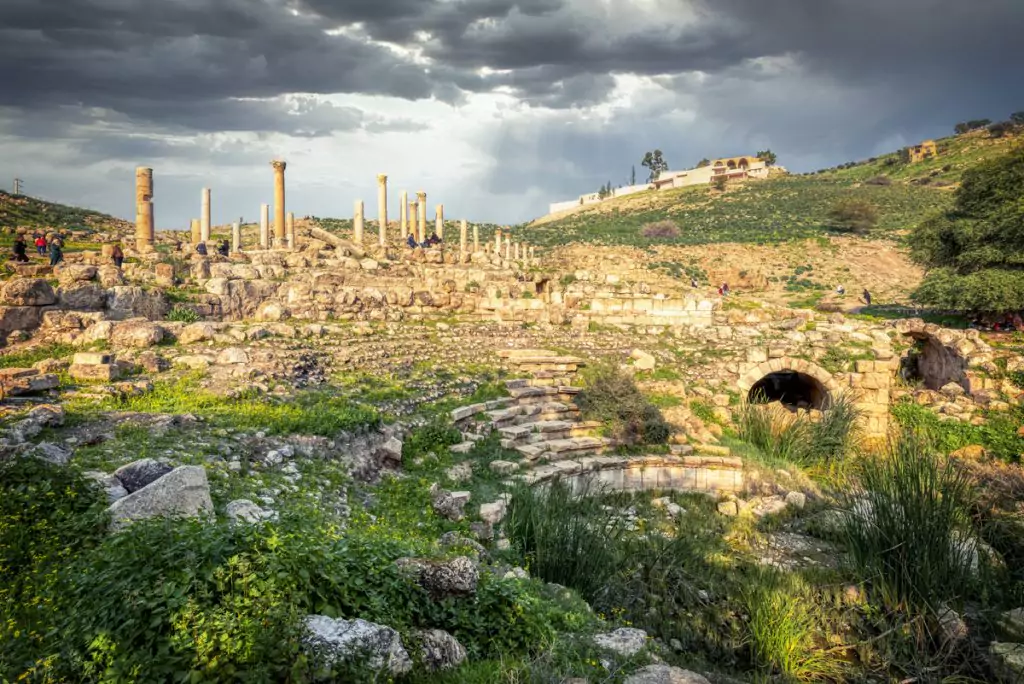Jordan, a land steeped in history and ancient wonders, offers a treasure trove of archaeological sites that transport visitors back in time. While Petra and Jerash often steal the limelight, hidden gems like Pella Jordan beckon those seeking a more intimate encounter with the past. Nestled amidst rolling hills and fertile plains, Pella boasts a captivating blend of Roman and Byzantine ruins, whispering tales of civilizations long gone. This comprehensive guide will unveil the wonders of Pella, providing you with all the information you need to plan an unforgettable journey to this captivating historical site.
Unveiling Pella Jordan: A Historical Overview
Pella Jordan, known in Arabic as Tabaqat Fahl, holds a significant place in history, its origins tracing back to the Chalcolithic period (4500-3600 BC). Over the centuries, this strategic location witnessed the rise and fall of empires, leaving behind a rich tapestry of archaeological remains. Pella’s story intertwines with the Greeks, who established a thriving city here in the Hellenistic period, naming it Pella after the birthplace of Alexander the Great. The Romans later conquered the region, and Pella flourished under their rule, becoming a prominent urban center. The Byzantine era saw the city embrace Christianity, evidenced by the numerous churches and basilicas unearthed within its boundaries.
Today, Pella stands as a testament to these bygone eras, offering a glimpse into the lives of those who walked its streets centuries ago. As you wander through the ruins, you’ll encounter remnants of Roman temples, Byzantine churches, and early Islamic settlements, each layer adding to the intricate narrative of this ancient city.
Exploring the Archaeological Wonders of Pella
Pella’s archaeological site is a sprawling complex, inviting exploration and discovery. Here are some of the must-see attractions that await you:
Pella’s Civic Complex: Heart of the Roman City
This area was the heart of Roman Pella, featuring a colonnaded street, a monumental fountain, and the remains of a temple dedicated to the god Zeus. Imagine the hustle and bustle of daily life as you stroll along the paved streets, picturing the citizens going about their business centuries ago.
Byzantine Churches of Pella: The West Church
Dating back to the Byzantine period, the West Church is a remarkable example of early Christian architecture. Marvel at the intricate mosaics that once adorned its floors, depicting biblical scenes and geometric patterns. These mosaics, though fragmented, offer a glimpse into the artistry and religious devotion of the time.
Exploring Pella’s East Church: Byzantine Architecture
Another significant Byzantine structure, the East Church, stands nearby, showcasing a different architectural style. Explore its ruins and imagine the echoes of prayers and hymns that once filled its halls.
Pella’s Odeon: A Glimpse into Ancient Entertainment
This small, well-preserved theater speaks to the cultural vibrancy of Pella. Envision the performances and gatherings that took place within its walls, transporting you back to a time of entertainment and social interaction.
Panoramic Views from Pella’s Upper Terrace
Climb to the Upper Terrace for panoramic views of the surrounding landscape. From this vantage point, you can appreciate the strategic location of Pella, overlooking the Jordan Valley and the distant hills.
The Pella Museum: Artifacts and Insights
Don’t miss the on-site museum, which houses a collection of artifacts unearthed during excavations. These objects, ranging from pottery and coins to jewelry and sculptures, provide further insights into the daily lives and cultural practices of Pella’s inhabitants throughout history.
Planning Your Visit to Pella: Practical Tips
To make the most of your visit to Pella, here are some practical tips:
- Getting There: Pella is located about 130 kilometers north of Amman, Jordan’s capital. You can reach the site by car or taxi. Public transportation options are limited, so renting a car or hiring a driver is recommended for convenience and flexibility.
- Opening Hours: The site is open daily from 8:00 AM to 4:00 PM in winter and until 6:00 PM in summer.
- Entrance Fees: The entrance fee is 3 JD (Jordanian Dinars).
- What to Wear: Wear comfortable shoes suitable for walking on uneven terrain. Dress modestly, especially when visiting religious sites.
- Facilities: Basic facilities, including restrooms and a small cafe, are available at the site.
- Guided Tours: Consider hiring a local guide to enhance your understanding of the site’s history and significance. Guides can provide valuable insights and answer your questions, making your visit more enriching.
Beyond Pella: Exploring Nearby Attractions in Jordan
While Pella offers a captivating journey into the past, the surrounding area also holds attractions worth exploring.
- Umm Qais: Just a short drive from Pella, Umm Qais boasts another impressive archaeological site with stunning views of the Golan Heights and the Sea of Galilee. Explore the ruins of Gadara, a Greco-Roman city known for its poets and philosophers.
- Ajloun Castle: Venture further afield to Ajloun Castle, a medieval fortress perched on a hilltop. Discover its fascinating history and enjoy panoramic views of the surrounding countryside.
- Jerash: If you haven’t already visited Jerash, consider adding it to your itinerary. This well-preserved Roman city offers a grander scale of ruins compared to Pella, showcasing colonnaded streets, temples, theaters, and a hippodrome.
Essential Travel Tips for Jordan
- Currency: The local currency is the Jordanian Dinar (JD). ATMs are widely available, and credit cards are accepted in most hotels and restaurants.
- Transportation: Renting a car is a convenient way to explore Jordan at your own pace. Taxis are readily available in cities and towns. For longer distances, consider using intercity buses or domestic flights.
- Language: The official language is Arabic, but English is widely spoken in tourist areas.
- Cultural Etiquette: Dress modestly, especially when visiting religious sites. It’s customary to remove your shoes before entering mosques and some homes. Bargaining is expected in souks (traditional markets).
Transliteration: Essential Arabic Phrases for Travelers
- Greetings
- Hello: As-salamu alaykum (as-salamu alaykum)
- Good morning: Sabah al-khair (Sabah al-khair)
- Good evening: Masaa al-khair (Masaa al-khair)
- Thank you: Shukran (shukran)
- You’re welcome: Afwan (afwan)
- Directions
- Where is…? Ayna…? (ayna…?)
- Left: Yasar (yasar)
- Right: Yameen (yameen)
- Straight ahead: Ala tool (ala tool)
- Dining
- The bill, please: Al-hisab, min fadlik (al-hisab, min fadlik)
- Delicious: Latif (latif)
- Water: Maa (maa)
- Emergencies
- Help: Al-musاعدة (al-musa’adah)
- Police: Shurta (shurta)
- Hospital: Mustashfa (mustashfa)
Real-Life Stories: Unforgettable Experiences at Pella
Many travelers have been captivated by the charm and historical significance of Pella. Here’s a story shared by a visitor:
“I visited Pella on a whim, having heard about it from a local. I was amazed by the tranquility of the site and the sense of discovery I felt while exploring the ruins. The views from the Upper Terrace were breathtaking, and the mosaics in the West Church were simply stunning. It was a truly unforgettable experience, and I highly recommend Pella to anyone seeking a unique and off-the-beaten-path adventure in Jordan.” – Sarah J.
Conclusion: Discovering the Hidden Gem of Pella
Pella, a hidden gem in Jordan, offers a captivating journey through time. With its blend of Roman and Byzantine ruins, stunning mosaics, and panoramic views, Pella is a must-visit for history buffs and those seeking an authentic travel experience. Explore the archaeological wonders, immerse yourself in the stories of the past, and discover the hidden treasures of this remarkable site.










